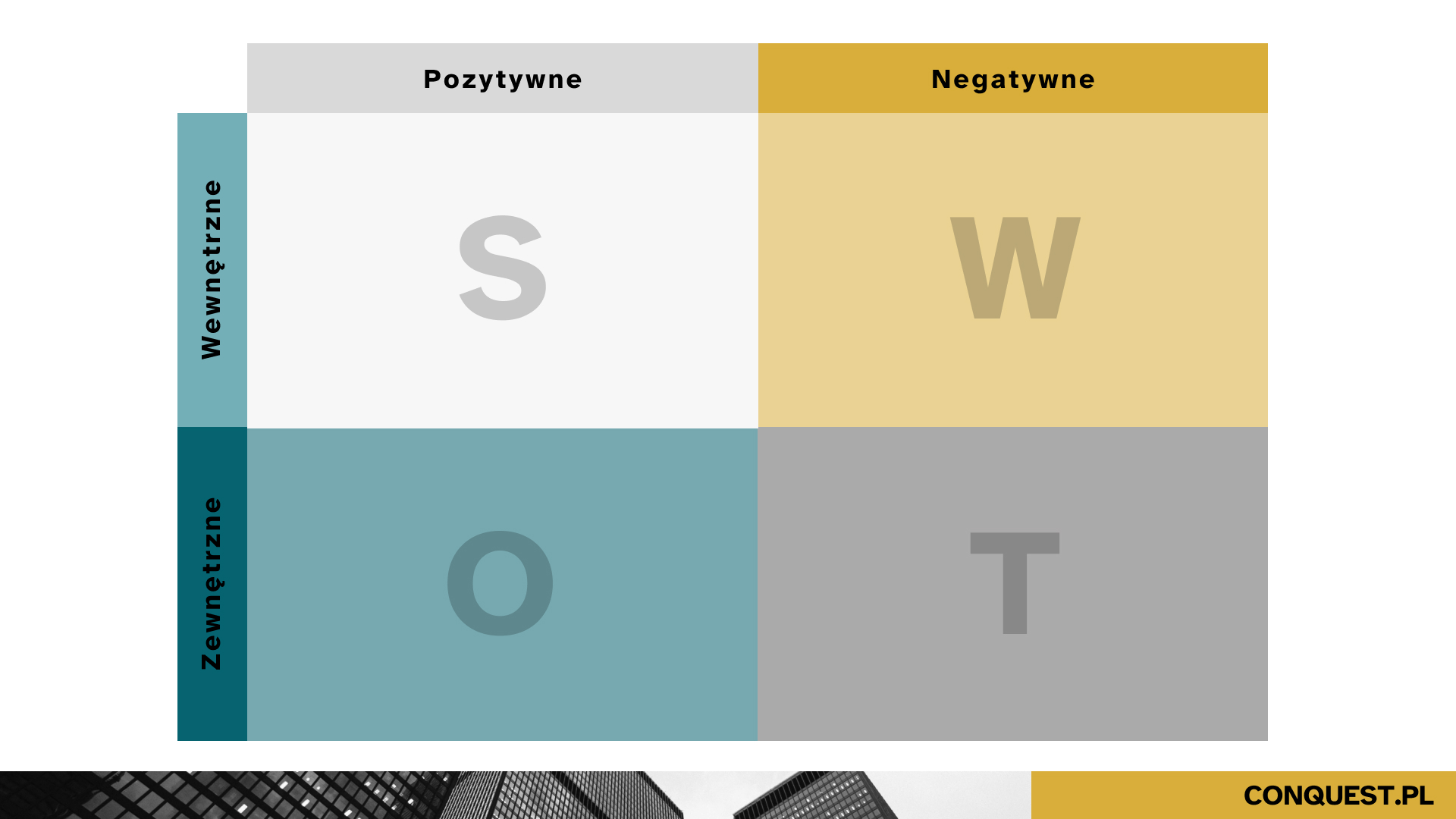21.05.2023
SWOT analysis - how it works and how to use it in business
Key information:
- SWOT analysis is an essential tool for strategic analysis in the context of business.
- SWOT analysis can be used both for the entire enterprise body and for its individual sectors, such as marketing, finance, production and many others.
- SWOT is an acronym that comes from the first letters of the English words: Strengths (strengths), Weaknesses (weaknesses), Opportunities (opportunities), Threats (threats).
- The SWOT method is particularly useful in strategic planning, launching a new product in the market, deciding whether to expand or restructure a company, as well as during competitive and market analysis.
- Conducting a SWOT analysis boils down to identifying all the key factors affecting a company's strategic situation in four analytical categories.
- In order for a SWOT analysis to be effective, both the different areas of the company and its environment must be thoroughly researched.
- A SWOT analysis consists of several main steps: defining objectives, identifying strengths, weaknesses, opportunities and threats, analyzing and interpreting the results, creating a strategy, implementing and monitoring.
- The SWOT analysis is also the starting point for selecting one of the four basic types of business strategy. These strategies are aggressive, defensive, conservative and competitive.
- A good approach is also to use other strategic analysis tools, such as Porter's 5 forces analysis, Astra analysis or PEST analysis, among others.
- Combined with other analytical tools, the results of the SWOT analysis can provide a good basis for making effective decisions on how to continue operating the company in a changing business environment.
Details below!

What is a SWOT analysis?
SWOT analysis is an essential tool for strategic analysis in the context of business. It can be applied both for the entire enterprise body and for its individual sectors, such as marketing, finance, production and many others. In addition, properly tailored to the specifics of the organization, SWOT analysis can serve as an initial step strategic analysis As part of advisory (consulting) services.
What does SWOT mean?
SWOT is an acronym that comes from the first letters of English words: Strengths (strengths), Weaknesses (weaknesses), Opportunities (Opportunities), Threats (hazards). The method was developed in the 1960s at Harvard University as part of a research project.
When to use SWOT analysis?
SWOT analysis is a versatile tool that can be applied to a variety of situations. It is particularly useful in strategic planning, launching a new product, making decisions about expansion or restructuring of the company, as well as during competition analyses i market analyses. In addition, SWOT analysis is an invaluable tool in the process of personal development, helping to identify strengths and weaknesses, as well as opportunities and threats on the career path. Thanks to its versatility, SWOT analysis works well in both individual and organizational contexts, contributing to a better understanding of the current situation and planning future actions.
If you need support in conducting an analysis, contact us!
How to conduct a SWOT analysis?
Conducting a SWOT analysis boils down to identifying all the key factors affecting a company's strategic situation in four analytical categories:
- Strengths
These are internal factors that positively distinguish a company from its competitors and unique strengths that can determine the competitive advantage of the company. These may include, for example, market leadership, unique know-how, capacity for growth, owned human resources, management staff, or owned production capacity.
- Weaknesses
That is, internal factors that have a negative impact on the achievement of the company's goals and objectives and its overall operation. These can include poor brand recognition, lack of required certifications and accreditations to start a new business, low and declining market share, limited financial resources or an atmosphere of fear among employees, or lack of ERP and CRM systems to support business processes.
- Opportunities
These are all external factors of a positive nature and opportunities that a company can use for its own development. These may include globalization, the development of information technology, a stable level of inflation, low interest rates or favorable environmental trends.
- Threats (Weaknesses)
These are external negative factors and risks to a given company's operations, such as an unstable regulatory environment, weakening demand for products from the industry in which the company operates, people's indifference to advertising, new taxes and an unfavorable regulatory environment.
SWOT analysis diagram

Effective SWOT analysis
For a SWOT analysis to be effective, it is necessary to thoroughly examine both the different areas of the company and its environment. When analyzing internal factors (strengths as well as weaknesses), the following areas of the company should be examined:
- knowledge, technology and R&D,
- HR,
- Sales and customer relations,
- logistics and production,
- Finance,
- Management and optimization of business processes.
On the other hand, when we look for external factors (opportunities and threats), it is necessary to analyze elements of the environment such as factors:
- political,
- economic,
- socio-cultural,
- technological,
- legal,
- Environmental.
By properly selecting areas for SWOT analysis, you will receive valuable information that will help the company better understand its position and direct its actions accordingly.
Stages of SWOT analysis
The SWOT analysis consists of several main stages that allow for a thorough understanding of an organization's internal and external situation.
- Defining Objectives: Before embarking on a SWOT analysis, each organization must clearly define its strategic goals, which the analysis is intended to help achieve.
- Identification of strengths and weaknesses: this stage involves identifying the organization's internal strengths and weaknesses.
- Identification of opportunities and threats: Next, the organization must examine its external environment to identify opportunities and threats. Opportunities are favorable conditions in a company's environment that can contribute to its growth, while threats are potential obstacles or risks.
- Analysis and interpretation of results: After identifying strengths, weaknesses, opportunities and threats, analysis and interpretation of this information follows. The goal is to understand how the company can capitalize on its strengths and opportunities, and how they can deal with weaknesses and minimize threats.
- Strategy making: Based on the results of the SWOT analysis, the company creates strategies that help it maximize the use of its strengths and opportunities, and minimize the impact of weaknesses and threats.
- Implementation and monitoring: The last step after creating a strategy, is to implement it. After that, its effects should be monitored to adjust activities and strategies on an ongoing basis.
SWOT analysis example
To make it easier to understand what a SWOT analysis is all about, we have provided an example of an analysis for a small food service business, which might look like the following:
S - strengths:
- unique recipes and flavors,
- High quality of meals served,
- excellent location,
- A team of experienced kitchen staff.
W - weaknesses:
- Lack of sufficient promotion and advertising,
- limited space for guests,
- No online ordering system,
- The high cost of renting and maintaining the premises.
A - opportunities:
- Increased interest in local, healthy foods,
- The possibility of expanding the offer to include catering or home delivery,
- The potential for creating themed culinary events,
- Introducing online ordering and delivery options.
T-hazards:
- Strong competition in the local food service sector,
- Food price fluctuations,
- Changes in the law on sanitary and health regulations,
- Demand volatility related to seasonality or changes in consumer trends.
A SWOT analysis conducted in this way will provide the company with valuable information that can help it make strategic decisions.

Determination of the enterprise strategy on the basis of SWOT analysis
The output of the SWOT analysis shows us the current situation in which the company finds itself. The most basic recommendations, essentially self-evident from the analysis, are to strengthen strengths and eliminate weaknesses, and to exploit opportunities and reduce threats.
The SWOT analysis is also the starting point for selecting one of the four basic types of strategy for the company's operations. These strategies are:
- aggressive strategy - The prevalence of strengths and opportunities. Targeting growth and market expansion.
- defensive strategy - The prevalence of weaknesses and threats. It is a mindset of defending and staying in the market and reducing weaknesses and threats first.
- conservative strategy - The prevalence of strengths with serious threats coming from the environment. The company should then use its strengths to overcome the threats and maintain its market position.
- competitive strategy - The prevalence of weaknesses with significant opportunities in the environment. In this strategy, the company eliminates weaknesses that prevent it from taking advantage of emerging opportunities.
Choosing the right strategy depends on the company's unique situation and the results of the SWOT analysis. When choosing a strategy, a company should aim to fully realize its goals and continuously grow.
SWOT analysis in practice
The conclusions and proposals for the types of strategy an enterprise should adopt from the SWOT analysis are very general. Managers and consultants must therefore determine how the strategy will be implemented, identifying specific actions or recommendations for decisions for the entire enterprise and individual areas. Undoubtedly, a good approach is also to use other strategic analysis tools, such as the following, among others. aPorter's 5 forces analysis, Astra analysis whether PEST analysis. The results from these analyses provide a more accurate and complete picture of the strategic situation of the business and effectively complement the often simple and obvious factors identified by the SWOT tool.
In addition, the SWOT method is prone to subjectivity. Often those conducting the analysis, in advance, expect certain results that will confirm their initial thesis, which will reduce the quality of the analysis conducted. Therefore, it is important to be objective and keep a distance during the study. It is also advisable to consult employees of different levels and departments in the company and approach them with equal weight, i.e. not to belittle the opinions of lower-level specialists compared to, for example, management. Such an orientation will broaden the perception of the organization of those conducting the analysis and provide an opportunity to confront the different perspectives of people in the organization.
SWOT analysis has for years remained the simplest and most popular method of strategic analysis of a company
Combined with other analytical tools, the results of the SWOT analysis can provide a good basis for making effective decisions on how to continue operating the company in a changing business environment.



